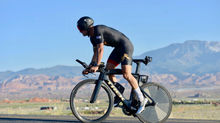Common Triathlon Injuries
- Jason Lentzke
- Jun 3, 2023
- 3 min read
Jason & Scott Ellis of Swing Physical Therapy discuss common triathlon injuries and how to overcome them. Here are some tips on how to avoid getting injured in the first place.
Stick to the Plan:
Follow your session’s guidelines and don’t be tempted to do an extra repetition or go harder than prescribed. I love Strava as much as anybody else, but save the KOM hunting for when it fits in with your session. As a multisport athlete, your next workout starts during the current one. Do the work, but more importantly, believe in the work you’re doing.
Fuel Your Session:
Underfueling your session can easily negatively impact future training sessions by increasing recovery time. Triathletes who put themselves into a nutritional deficit are much more prone to injury, fatigue and general irritability. Fueling strategies are unique to each athlete and usually dictated by an athlete’s sweat rate and the training environment. For a 90-minute session, I recommend drinking 20-22 ounces of water per hour during exercise. If you’re deep into training cycle aim to drink 8-10 oz of a sports drink (with no more than 8% carbohydrate) every 20 minutes and a gel every 30 minutes.
Refuel & Rehydrate:
If your session included intensity or was more than 60 minutes, it’s critical to get in a regenerative meal within 15-20 minutes of completing your training. Your body is particularly responsive to carbohydrates (replenish glycogen stores) and protein (repair muscle trauma) during this 15-20 minute window, so it’s imperative to have your post workout meal timely. It’s especially important if you have another session on the same day. I recommend consuming at least half of your body weight in ounces of water daily in addition to what you sweat out during your session. For every pound of water weight lost (16 oz of sweat), drink 2-3 cups of water. A good post workout recovery snack for a 90-minute session is a simple smoothie with greek yogurt, banana, nut butter and ice. Eat real food that will reduce inflammation and stabilize blood sugar.
Shake it Out:
Go for a very easy 10 min jog/run after a hard bike session to improve blood flow, flush out lactic acid and loosen up your legs. This will expedite your recovery time and improve your run durability. It doesn’t need to be fast to be effective. Slow is pro!
Keep Moving:
Don’t stack consecutive hard running days. Remember that in order to go fast, sometimes you need to go slow—even embarrassingly slow at times. Slow is pro, remember? Riding easy the day after a hard run session is a good way to absorb fitness and expedite recovery. There are times in your season when you need to train hard over consecutive days. But, most of the time, insert a a swim, easy ride or an easy run the day after a demanding session.
Massage:
A monthly recovery massage can reduce tightness, increase blood flow and manipulate fatigued muscles that will reduce recovery time. Find a massage therapist that knows the triathlete’s body well.
Sleep Harder:
Establish a consistent routine by going to bed and waking up at the same time each day. Turn your smart phone/tablet off at least 60 minute before your head hits the pillow to help quiet your mind. Try to pick up a book instead of falling asleep to the glow of a TV. Seven to eight hours of sleep per night is OK, but 8-10 is better. You’d be surprised how much better you feel even with just 30 minutes of extra sleep.
Avoid NSAIDs During Exercise:
When a dehydrated endurance athlete ingests NSAIDs (ibuprofen, aspirin and naproxen) during exercise, the athlete’s kidneys can become overwhelmed. This increases the risk of hyponatremia (dilution of electrolytes within the body), which will cause the brain to swell. The end result could be a trip to the ER or even worse. Any pain or inflammation that flares up while training is not something you should medicate with NSAIDs, but a signal that it’s time to reevaluate your training plan.
Listen to Your Body:
The omnipresence of technology and gadgets in the current state of triathlon can make it easy to get hung up on the metrics while you’re training. However, the strongest and most accurate computer is between your ears. If your training session calls for intervals and your body is telling you that it’s not going to happen, respect that. Let your coach know that you simply didn’t have the legs for the prescribed workout and move on. That is part of being an athlete. In order to avoid injury, listen to your body and schedule a weekly rest day to help keep your training consistent week after week, month after month.























